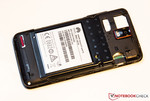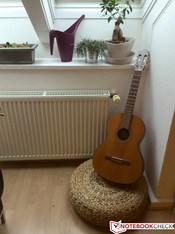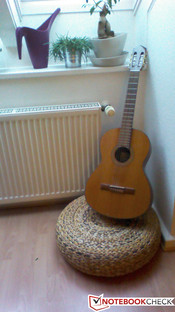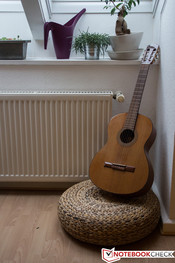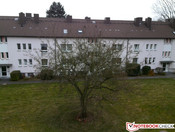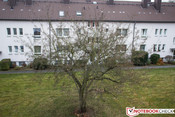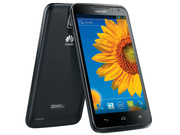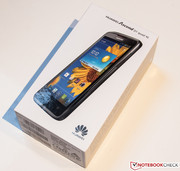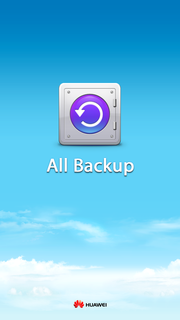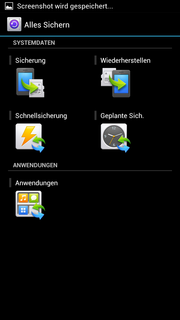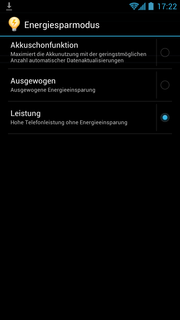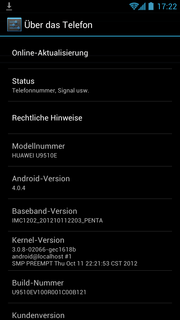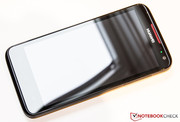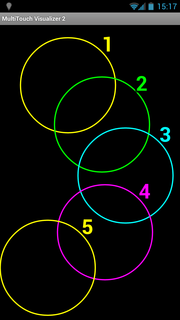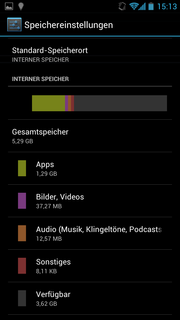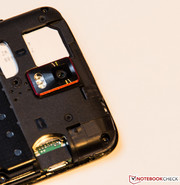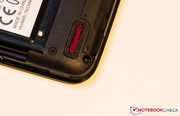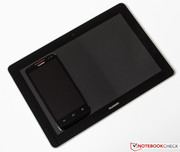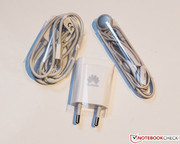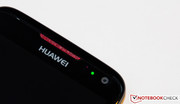Review Huawei Ascend D1 Quad XL Smartphone

For the original German review, see here.
As we already reported on the 01.03.2012, the in-house HiSilicon K3V2 Hi3620 quad-core SoC was to be used for the MediaPad 10 FHD, as well as the Ascend D1 Quad XL. Now, more than six months later, we are holding the device in our hands and will deliver our comprehensive verdict on it. Not only the same SoC as in the MediaPad 10 is contained within our reviewed device, but we are also already familiar with other defining characteristics from the previously reviewed Full HD tablet. The name "Quad XL" initially led us to expect a larger than usual display. In these times of the Samsung Galaxy Note 2 people will however begin to ask themselves just how big a smartphone can actually get. That's why we were somewhat surprised when we saw the device for the first time, and the Android 4.0 (Ice Cream Sandwich) equipped smartphone "only" had a 4.5-inch display. Huawei has opted for 1 GB of RAM, an IPS display with Corning Gorilla Glass, and just about 8 GBs of internal memory. The latter of which can however be expanded by up to an additional 32 GBs via the MicroSD slot.
We already took a closer look at the bigger brother, and established that it worked up quite a sweat in terms of the processing performance during benchmarks and 3D games. Huawei has increased the processing speed of each core by an additional 200 MHz, which leads to a clock speed of 1.4 GHz. How the Ascend D1 Quad XL fares with this upgrade can be discovered in the following review.
Case
When taking the smartphone into your hands for the first time, one thing in particular immediately stands out - the thickness. With 11.5 mm (~0.45 inches) this smartphone is significantly bulkier than most of the other competitors, and even thicker than many tablets. Contrary to what many might assume, we do not rate this as a negative though, since the Ascend D1 Quad XL lies well in your hand for precisely this reason. In terms of the length and width (129.9 mm x 64.9 mm/~5.11 x 2.56 inches) it is smaller than the HTC One S (130.9 mm x 65 mm/~5.15 x 2.56 inches), although the latter of these has a 0.2 inch smaller display. The weight comes in at 145 grams (~0.32 pounds), which is 12 grams (~0.42 ounces) heavier than the substantially bigger Samsung Galaxy S3.
The back cover is entirely made of black plastic with an engraved pattern. Although Samsung also adopts plastic for its Galaxy series, it is able to tout a lighter weight depending on the size of the device. Why the Ascend D1 Quad XL is so heavy cannot be fully explained by us. Most likely this is related to the rigidity of the device, in terms of which Huawei is setting new standards, and which can be compared to that of a brick. Even when we push and pull at all corners with a lot of strength, we are only able to cause a minimal warping of the case. The plastic back cover on the other hand can be dented inwards by a millimeter in the center. Removing the cover immediately shows a point of criticism. The battery, with a capacity of 2600 mAh, cannot be changed. The camera and the dual-LED flash are both enclosed in the metal, which has a different colored frame (Bordeaux red). The display frame is slightly raised compared to the touchscreen in order to try to avoid scratching.
Features
As already mentioned at the beginning of the review, Huawei has included a more or less identical configuration in their current Full HD tablet. The SoC from HiSilicon has a clock speed of 1.4 GHz in the Ascend D1 Quad XL, and 1 GB of RAM, as well as a "16 Core GPU" Vivante (GC4000) graphics unit. On the other hand, the resolution of the display cannot stand up to that provided by the MediaPad 10. The 4.5-inch display offers a native resolution of 1280x720 pixels. Regarding software, the Huawei runs Google's Android 4.0.4 (Ice Cream Sandwich). In terms of colors ("matte black") or the internal storage, which lies at 8 GBs (5.29 GB freely available), there are no options available. Remedial relief is provided by the MicroSD slot, which is able to expand the memory capacity by up to an additional 32 GBs. Both of the cameras are capable of recording video with HD quality. The main camera on the back has an 8 megapixel sensor (+BSI: Back Side Illumination with autofocus), while the front camera has to make due with 1.3 megapixels.
Just two hardware buttons are used with the reviewed device. One of these is the power button at the top towards the right, and the other is the volume control on the right side. The feedback from both of these is satisfactory. For charging the MediaPad 10 FHD uses a 30-pin dock interface, while our reviewed device uses a Micro USB port on the left side.
Communication & GPS
In order to be classified as a high-end device, certain standards have to be fulfilled of course. The Ascend D1 Quad XL makes use of an A-GPS module (GLONASS), which quickly connects (in enclosed rooms) with sufficient satellites, and is able to maintain a stable reception. The communications interface Bluetooth (version 3.0) shouldn't be absent either, just as much as a WLAN module, the latter of which operates using the standards 802.11 b/g/n in the Ascend D1 Quad XL. Only a few short moments pass before the WLAN connection is established, and during our test we were not able to determine any unexpected interruptions. The HSPA interface operates with a download speed of 21 Mbit/s in order to provide an up-to-date data exchange over the mobile network.
Software
Even though the first Windows 8 phones are already being sold, Huawei has opted for the already established Google Android operating system in its 4.0.4 (Ice Cream Sandwich) version; they have aligned themselves with the Google standard when it comes to the home screen and App Drawer, without making any significant changes compared to the MediaPad 10. Within the settings the "power-saving profile" has been integrated, which allows users to choose between three different power efficient presets - although the practical use is somewhat debatable.
Cameras & Multimedia
Huawei has opted for two camera modules. The front camera has a resolution of 1.3 megapixels, while the back camera has a resolution of 8 megapixels as well as a dual-LED flash, BSI with autofocus, and HDR effect optimization. Both cameras are capable of recording HD quality video, and the back camera can even record Full HD video. Cameras on other smartphones don't have a substantially higher resolution either (Galaxy S3: Back 8 MP, front 1.9 MP).
Comparing the taken photographs, a big similarity to the test pictures taken with the MediaPad 10 FHD is observable. For this reason we are assuming that both devices make use of the same photo sensor. Accordingly, the verdicts also correspond: The pictures are lacking detail and definition, whereby the front camera stands out especially negatively. We would use the front camera exclusively as a webcam, and the main camera only for taking occasional photographs if there aren't any better alternatives available. When it comes to video recordings with Full HD quality, the definition is once again less than ideal. The color representation looks a little pale and is strongly dependent on the lighting conditions. Transitions from bright to dark are quickly recognized.
Accessories
Huawei isn't able to make the Ascend D1 Quad XL stand out from the mass of smartphones with the accessories. The packaging contains a modular AC adapter, several short manuals and a headset (not In-Ear headset). Further accessories have to be procured from third parties, since the Huawei product website doesn't contain a shop.
Warranty
Huawei provides the Ascend D1 Quad XL with a warranty period of 12 months.
Input Devices & Operation
The capacitive touchscreen reacts precisely to commands, and copes well with multi-touch gestures. Pinch-to-zoom and tap-to-zoom are only two of the many gestures that are supported. Preinstalled is a keyboard from Huawei, which takes up just over 50% of the display with the landscape layout. If the navigation bar of the browser is open at the same time for example, then there is not much else left to see of the remaining display content. The automatic turning of the display starts after a short delay, but once the orientation sensor reacts the actual turning takes place very quickly.
Similar to the Nexus models from Google, the Ascend D1 Quad XL completely forgoes physical buttons in the navigation bar.
Display
The IPS TFT display on the Ascend D1 Quad XL has a diagonal length of 11.59 cm (~4.56 inches). We may not know whether the "XL" in the product name is supposed to pertain to the size of the display, but with 4.5 inches it is definitely not a very small smartphone. Thanks to the HD resolution of 1280x720 pixels together with the display size, this results in a pixel density of 326 PPI, which is therefore higher than with the Google Nexus 4 (318 PPI) or the Samsung Galaxy S3 (306 PPI).
Our measurements attest to a maximum display brightness of 431 cd/m² in the lower middle area of the reviewed device, with an illumination distribution of 92% over the whole of the display. On average the Ascend D1 Quad XL manages 411.2 cd/m² and therewith positions itself ahead of many other high-end smartphones. The Galaxy Note 2 and the Galaxy S3 for example only manage to reach brightness levels of 230.3 cd/m² and 148 cd/m² respectively in this discipline. In terms of the display, the Apple iPhone 5 clearly sets the standard. With an average brightness of 486.8 cd/m² it edges ahead of our reviewed device. The black level of 0.41 cd/m² on the Ascend D1 Quad XL meanwhile is marginally better than that on the iPhone 5 (difference 0.07 cd/m²), which leads to an almost identical contrast ratio on both of the devices. Our test candidate reached a respectable 1010:1 (iPhone 5: 1040:1).
| |||||||||||||||||||||||||
Brightness Distribution: 92 %
Center on Battery: 414 cd/m²
Contrast: 1010:1 (Black: 0.41 cd/m²)
Measured values do not always correspond to subjective interpretation. With a direct comparison of the display to that of the Samsung Galaxy S3 using the maximum brightness, the Galaxy S3 looks a little brighter, despite the fact that it is substantially dimmer according to the measurements.
In direct sunlight the reflections on the display are clearly visible. Countering this is the high display brightness, which tries to compensate for this problem, and succeeds to a reasonable extent. Display contents can be recognized well, and allow for Internet websites or videos to be enjoyed outdoors on a sunny day.
Performance
The review of the Huawei MediaPad 10 FHD has already provided us with detailed insights relating to the performance of the new SoC. The results were unfortunately not very convincing in either the browser-based, or the synthetic based benchmarks. In order to compensate, Huawei has increased the clock speed of each core by 200 MHz, which means that the quad-core now operates at a speed of 1.4 GHz. Further characteristics of the SoC and the RAM haven't changed. To what extent this rather marginal change has impacted the performance, has been tested by us using the same benchmarks.
Especially with the synthetic tests, such as Smartbench or Vellamo, a significant difference of up to 49% compared to the MediaPad 10 FHD can be observed. Juxtaposed against other smartphones our reviewed device even manages to perform considerably better in some cases. The AnTuTu Benchmark v2 ascribes the Ascend D1 Quad XL (12553 points), Galaxy S3 (12208 points) and the Galaxy Note 2 (13637 points) a more or less similar score. When it comes to browser-based benchmarks meanwhile, the MediaPad 10 and the Ascend D10 Quad XL are more or less identical, but aren't able to compete with their rivals. In order to determine the sequential read and write speed of the flash memory we used AndroBench 3. With 36.6 MB/s while writing, our reviewed device manages to edge ahead of the Galaxy Note 2 (difference: 19%), but is still 5 MB/s slower than the MediaPad 10.
| AndroBench 3-5 | |
| Sequential Write 256KB (sort by value) | |
| Huawei Ascend D1 Quad XL | |
| Samsung Galaxy S3 | |
| Huawei MediaPad 10 FHD | |
| Samsung Galaxy Note II GT-N7100 | |
| Sequential Read 256KB (sort by value) | |
| Huawei Ascend D1 Quad XL | |
| Samsung Galaxy S3 | |
| Huawei MediaPad 10 FHD | |
| Samsung Galaxy Note II GT-N7100 | |
| AnTuTu v2 - Total Score (sort by value) | |
| Huawei Ascend D1 Quad XL | |
| Samsung Galaxy S3 | |
| Huawei MediaPad 10 FHD | |
| Samsung Galaxy Note II GT-N7100 | |
| HTC One X | |
| Google V8 Ver. 7 - Google V8 Ver. 7 Score (sort by value) | |
| Huawei Ascend D1 Quad XL | |
| Samsung Galaxy S3 | |
| Huawei MediaPad 10 FHD | |
| Samsung Galaxy Note II GT-N7100 | |
| HTC One X | |
| Sunspider - 0.9.1 Total Score (sort by value) | |
| Huawei Ascend D1 Quad XL | |
| Samsung Galaxy S3 | |
| Huawei MediaPad 10 FHD | |
| Samsung Galaxy Note II GT-N7100 | |
| HTC One X | |
| Vellamo Mobile Benchmark 2.0 - Metal (sort by value) | |
| Huawei Ascend D1 Quad XL | |
| Samsung Galaxy S3 | |
| Huawei MediaPad 10 FHD | |
| Browsermark - --- (sort by value) | |
| Huawei Ascend D1 Quad XL | |
| Samsung Galaxy S3 | |
| Huawei MediaPad 10 FHD | |
* ... smaller is better
The test results show that the increased processor speed has had a positive impact. In some cases significant improvements were observed, and the overall performance of the Ascend D1 Quad XL has edged closer to that of a high-end device.
Videos with Full HD quality are played back by the smartphone without difficulties. In order to come to this conclusion we watched the trailers for Transformers III and James Bond’s Skyfall with a 1080p resolution, whereby we weren't able to discern any problems.
Games
Current games don't represent too much of a challenge for the Ascend D1 Quad XL. Compared to the Huawei MediaPad 10 FHD, the smartphone also comes to terms with up-to-date 3D games without any considerable difficulties. After all, it has a whole 200 MHz extra clock speed per core on its side, and the display has a lower resolution. Since processing intensive 3D games doesn't constitute a significant hurdle, it should be obvious that classic games such as Angry Birds and other 2D games are a cakewalk.
Audio Quality
During several test conversations we were able to attest to a consistently good microphone and speaker quality. We were able to hear voices clearly and pleasantly, and were equally well heard. There weren't any unexpected interruptions, nor were we able to complain about the maximum available volume.
Emissions
Temperature
The temperature profile of the smartphone doesn't give us cause for concern at any point. When fully utilized, a maximum of 42.4 degrees Celsius (108.32 degrees Fahrenheit) is reached in the upper third of the device. Below this we measured values of 35 degrees (95 degrees Fahrenheit) on the front, and even lower temperatures on the back. Meanwhile when the Ascend D1 Quad XL is only utilized to a limited extent, we were only able to measure a warm maximum temperature of 33.9 degrees Celsius (93.02 degrees Fahrenheit). Also harmless is the temperature of the modular AC adapter, which reaches temperatures of 39.1 degrees (102.38 degrees Fahrenheit) when utilized, and 33.7 degrees (92.66 degrees Fahrenheit) in an idle state.
(±) The maximum temperature on the upper side is 42.4 °C / 108 F, compared to the average of 35.2 °C / 95 F, ranging from 21.9 to 247 °C for the class Smartphone.
(±) The bottom heats up to a maximum of 41.7 °C / 107 F, compared to the average of 34 °C / 93 F
(±) In idle usage, the average temperature for the upper side is 32.8 °C / 91 F, compared to the device average of 32.9 °C / 91 F.
Speakers
The integrated speaker is located underneath a recess in the back cover on the bottom. The first thing we immediately noticed was that a minimum volume of about 35% had to be set in order to listen to music with suitably quiet surroundings. The next problem is the dynamic range. With a high volume the sound is slightly distorted and sounds metallic. For enjoying music with a high volume users probably won't get around using headphones. And even though the included headset is better than the integrated speaker, we certainly wouldn't describe the sound as high-quality audio.
Battery Life
Power Consumption
Comparing the power consumption with that of smartphones with other processor architectures shows that they all use less power than the Ascend D1 Quad XL. Thanks to the small display it is however not as ravenous as Huawei's tablet version, the MediaPad 10. Thus our reviewed device requires between 1.4 and 2.4 Watts in an idle state. The Galaxy S3 meanwhile makes do with 1.2 to 1.5 Watts (4.8-inch display), and the equally dimensioned HTC One X comes to terms with between 0.6 and 1.5 Watts. In case the performance demands begin to increase, then the Ascend D1 Quad XL manages to achieve commendable values of between 4.9 and 6.9 Watts.
The new SoC from HiSilicon turns out to be very power-hungry, and isn't able to compete with its rivals in terms of energy efficiency. If the manufacturer were to get a better grip on the power consumption, then we would expect the potent battery (2600 mAh) to aid in achieving very good runtimes.
| Off / Standby | |
| Idle | |
| Load |
|
Key:
min: | |
Battery Runtime
The measured runtime duration in three different scenarios reflects the previously determined power consumption characteristics. As a result of permanently high processing utilization, we weren't able to achieve any convincing results. The competition from Samsung, HTC and Apple is definitely superior to Huawei in this discipline. In an idle state, with the display set to its lowest brightness level, and the wireless modules switched off, the smartphone manages to stay operational for 12 hours and 8 minutes. The idle runtime wonder Apple iPhone 5 however manages an additional 10 hours in comparison. Also in practical scenarios such as the WLAN surf test things don't look too good. With 5 hours and 33 minutes, the Ascend D1 Quad XL doesn't even begin to approach the endurance of other high-end devices. A light at the end of the tunnel begins to emerge during the full utilization scenario though. 2 hours and 50 minutes are possible with the reviewed device. With the exception of the Galaxy Note 2 (4:09 hours) and the Galaxy S3 (4:29 hours), the HTC One X (1:52 hours) and the iPhone 5 (2:02 hours) run out of steam significantly sooner. Unfortunately the damage has already been done, since a 100% utilization of the CPU and GPU is very rare during daily use. A full charge cycle takes 3 hours and 9 minutes.
Verdict
We initially posed the question whether the Huawei Ascend D1 Quad XL is merely a cheap imitation of the MediaPad 10 FHD, since all the components with the exception of the Full HD display are identical, and have merely been packaged into a smaller case. It’s almost as if half of the case was simply streamlined away, and you were left with a new product in the portfolio. It’s not quite as simple as that though, since fundamental flaws were also ironed out in our opinion. The average display brightness was increased by over 80%, and thanks to an increase in the processor clock speed, as well as a reduced display resolution, it is also possible to play power-hungry 3D games without any difficulties. Performance and brightness however usually improve at the expense of the battery life. Combined with an already ravenous SoC, there is only one thing left that can help - a potent battery. With 2600 mAh Huawei is attempting to compensate in order to extend the battery life, and have to come to terms with an 11.5 mm (~0.45 inch) thick case. Unfortunately this plan doesn't completely come to fruition. With 5 hours and 33 minutes of battery life in a practical WLAN test, the Ascend D1 Quad XL falls behind the competition.
The manufacturing quality on the other hand is laudable. The somewhat thicker case lies in the hand pleasantly and doesn't weigh too heavy in your pocket, while being as solid as a rock.
The bottom line is that buyers will receive a well constructed device suitable for daily use with a bright display, sufficient performance reserves, and plenty of potential for fun. The Ascend D1 Quad XL tackled all the tasks we threw at it without any problems, and still had plenty of reserves available. Nevertheless, criticism is still attributable to the short battery life and the non-replaceable battery - but then again who or what is perfect? We see the Huawei Ascent D1 Quad XL as a real alternative to high-end devices from Samsung, HTC or Apple.




